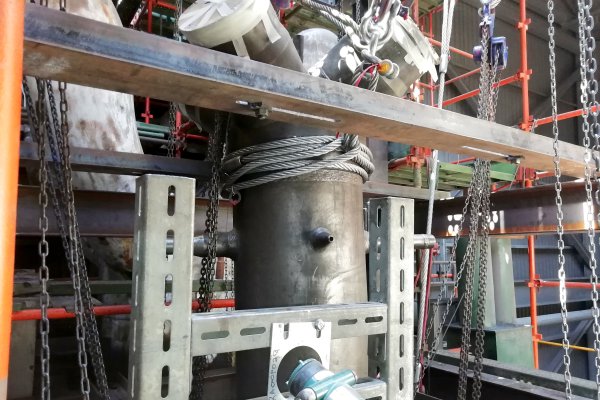Babcock was successful in its tender and was awarded the work to undertake the design, procurement and supply, fabrication, manufacture, and construction of the complete mainsteam and high-pressure bypass system for the power unit. Babcock prevails under pressure
Babcock prevails under pressure
Keagan Naidoo, Piping Engineering Manager at Babcock Ntuthuko Engineering, explains that a complex project of this nature taking into account the engineering scope, manufacturing, logistics and the scope of construction involved, usually takes 18 to 24 months to execute. However, Babcock successfully completed the project in just seven months, working under pressure to restore the additional power capacity.
In order to assess the extent of the damage, Babcock used a combination of visual inspection and 3D scanning technology to scan the piping system and associated structures. Using specialised software, Babcock was able to digitise the real-world architecture by capturing existing plant conditions and complex geometry, resulting in a digital copy, which identified that large sections of pipework and structures had been displaced during the rupture.
Babcock was tasked to design the replacement system whilst establishing a safe working environment to enable the safe removal of the damaged sections of pipework; source and supply the replacement hardware on the piping system; and install it.
As part of removing the existing ‘as-damaged’ piping system, various techniques using load-bearing scaffolding and ratchet type restraints were employed to remove residual spring due to the event and prevent further displacement.
Naidoo explains that even though this was a replacement, the complexity of adhering to the latest standards and the introduction of design smarts such as cold-pull and additional pipe supports rendered most of the existing design information irrelevant. He explains that cold-pull is a process whereby the piping system is pre-stressed in its cold state such that it is least stressed in its hot state, which will maximise design life.
As part of the design process, Babcock performed pressure containment calculations, performing stress analysis to size the replacement components and then created manufacturing drawings to facilitate machining, fabrication and construction.
He says that the project was logistically demanding as specialty items such as forgings and piping had to be manufactured in Europe and delivered to South Africa within the strict project timelines, while complying with the best practices in accordance with the latest international design codes available, and benefiting from the design smarts to minimise calculated stresses.
Once the raw material arrived on site, Babcock was able to commence with machining and welding of piping sub-assemblies, installing of temperature thermo-couples and condensate drain outlets, before site construction.
“As the project deadline approached, construction timelines proved to be demanding due to the inclusion of specialty processes such as balanced erection and neutral float, areas in which Babcock is highly experienced,” says Naidoo.
He explains that individual pipe spools and sub-assemblies of pipework and fittings were erected and hung into pre-determined locations. Load cells were used at selected locations on these spools and sub-assemblies and cell readings were compared to the calculated balanced loads. Once actual loads were within range of the calculated loads, the spools and sub-assemblies were balanced before the welds could be completed.
Upon completion of piping erection, a neutral float procedure was used to prove the system piping support effort and success of the balanced erection procedure. After neutral float acceptance, terminal point welds were completed.
Approximately 85% cold-pull was installed in the piping system using various control monitoring processes to ensure that the correct moments were introduced and distributed throughout the sub-sections as per cold pull-calculations.
“Quality control measures which formed key gate keepers leading to cold handover proved challenging as the majority of this was done over the festive season, meaning the availability of resources from sub-contractors was not as abundant as other periods,” says Naidoo.
“With great effort, dedication, teamwork from both Babcock and the client’s side, and many late nights and weekends, the unit was successfully and safely synchronised to the power grid in record time,” he concludes.

